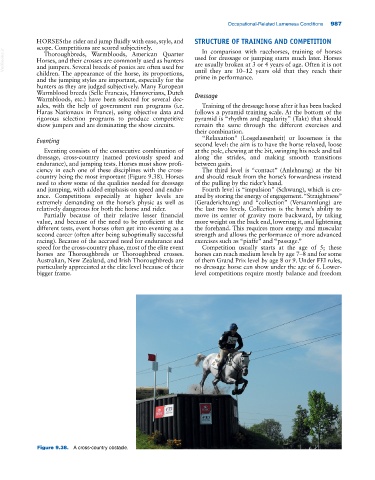Page 1021 - Adams and Stashak's Lameness in Horses, 7th Edition
P. 1021
Occupational‐Related Lameness Conditions 987
HORSESthe rider and jump fluidly with ease, style, and STRUCTURE OF TRAINING AND COMPETITION
scope. Competitions are scored subjectively. In comparison with racehorses, training of horses
VetBooks.ir Horses, and their crosses are commonly used as hunters used for dressage or jumping starts much later. Horses
Thoroughbreds, Warmbloods, American Quarter
are usually broken at 3 or 4 years of age. Often it is not
and jumpers. Several breeds of ponies are often used for
children. The appearance of the horse, its proportions, until they are 10–12 years old that they reach their
and the jumping styles are important, especially for the prime in performance.
hunters as they are judged subjectively. Many European
Warmblood breeds (Selle Francais, Hanoverians, Dutch
Warmbloods, etc.) have been selected for several dec Dressage
ades, with the help of government run programs (i.e. Training of the dressage horse after it has been backed
Haras Nationaux in France), using objective data and follows a pyramid training scale. At the bottom of the
rigorous selection programs to produce competitive pyramid is “rhythm and regularity” (Takt) that should
show jumpers and are dominating the show circuits. remain the same through the different exercises and
their combination.
Eventing “Relaxation” (Losgelassenheit) or looseness is the
second level: the aim is to have the horse relaxed, loose
Eventing consists of the consecutive combination of at the pole, chewing at the bit, swinging his neck and tail
dressage, cross‐country (named previously speed and along the strides, and making smooth transitions
endurance), and jumping tests. Horses must show profi between gaits.
ciency in each one of these disciplines with the cross‐ The third level is “contact” (Anlehnung) at the bit
country being the most important (Figure 9.38). Horses and should result from the horse’s forwardness instead
need to show some of the qualities needed for dressage of the pulling by the rider’s hand.
and jumping, with added emphasis on speed and endur Fourth level is “impulsion” (Schwung), which is cre
ance. Competitions especially at higher levels are ated by storing the energy of engagement. “Straightness”
extremely demanding on the horse’s physic as well as (Geraderichtung) and “collection” (Versammlung) are
relatively dangerous for both the horse and rider. the last two levels. Collection is the horse’s ability to
Partially because of their relative lesser financial move its center of gravity more backward, by taking
value, and because of the need to be proficient at the more weight on the back end, lowering it, and lightening
different tests, event horses often get into eventing as a the forehand. This requires more energy and muscular
second career (often after being suboptimally successful strength and allows the performance of more advanced
racing). Because of the accrued need for endurance and exercises such as “piaffe” and “passage.”
speed for the cross‐country phase, most of the elite event Competition usually starts at the age of 5; these
horses are Thoroughbreds or Thoroughbred crosses. horses can reach medium levels by age 7–8 and for some
Australian, New Zealand, and Irish Thoroughbreds are of them Grand Prix level by age 8 or 9. Under FEI rules,
particularly appreciated at the elite level because of their no dressage horse can show under the age of 6. Lower‐
bigger frame. level competitions require mostly balance and freedom
Figure 9.38. A cross‐country obstacle.

